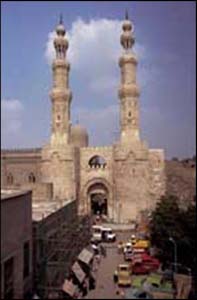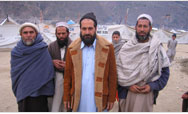 |
You are here » Home » Telling Our Story
|
USAID funds restoration of treasured Islamic monument – the Bab Zuweila project
|
| Preserving Landmark Antiquity in Islamic Cairo |
|
Bab Zuweila, a treasured 900-year-old Islamic monument, is located in the heart of historic Cairo. Easily identified by its famous twin minarets, the landmark is one of the finest examples of fortified architecture predating the Crusades. With the passage of time, however, moisture, air pollution, and traffic wore away the structure, and urban development obscured its original layout.
The name "Zuweila" comes from a North African Berber tribe that settled in the old southern quarter of Egypt, and "Bab" means gate. The gate and adjoining circular stone towers were built in 1092 during the rule of the Fatamids, before the Crusades. Designed to defend the city from Turkish armies, the metal-shrouded doors had not been moved in 500 years until the restoration began in 1998. A Mamluke Sultan built the 80-meter (260-foot) minarets on the top of the gate's adjoining towers.
|

|
The U.S. has provided more than L.E. 55 million funding for the preservation and restoration of antiquities in Islamic Cairo, Coptic Cairo, Luxor, Alexandria, and at Red Sea sites.
USAID, through at 2.8 million Egyptian Pound (LE) grant, funded a restoration project for the American Research Center in Egypt to restore and protect the monument in cooperation with Egypt’s Supreme Council of Antiquities. An international team led by an Egyptian expert began the restoration in 1998, and a completion ceremony was held September 14, 2003.
|
| Photo: USAID/Egypt |
|
|
| |
During the restoration, local stone masons hand-picked materials from Egyptian quarries to replace deteriorated sections of the towers. Modern cleaning technology enabled the removal of centuries of grime. During the five-year restoration, offerings were found including handwritten notes asking for spiritual intercession as well as artifacts such as Chinese coffee cups with Arabic inscriptions and Ottoman pipes which are now being displayed in cases near the gate.
The Bab’s structure is now open to visitors through an entrance that had been hidden for centuries until re-discovered during the project. The southern gateway of the walled city, Bab Zuweila became over time a site for commerce, religious devotion, processions, celebrations and justice.
Now, the landmark affords visitors an impressive view of the Islamic city from its ramparts. Inside visitors can take self-guided tours, reading illustrative panels about the history of the monument and the project. A nearby mosque, prayer house, school and public drinking fountain are also part of the Egyptian Antiquities Project.
|
|
Print-friendly version of this page (244kb - PDF)
Back to Top ^
|


